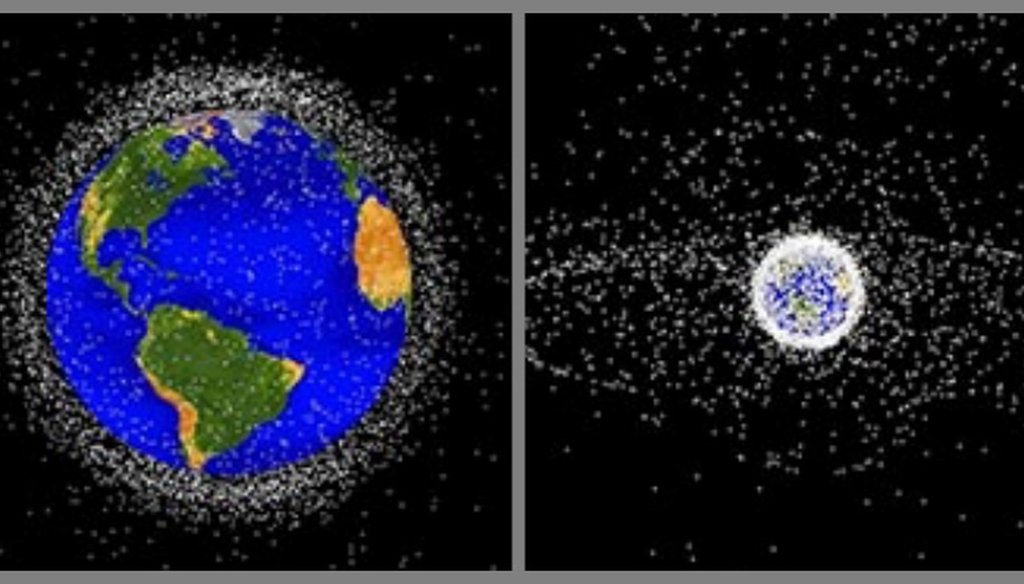Stand up for the facts!
Our only agenda is to publish the truth so you can be an informed participant in democracy.
We need your help.
I would like to contribute

On the left, NASA graphic of space junk in low Earth orbit. On the right, the view from further out. (NASA ODPO)
Chunks of solar panels, old rocket bodies, dead satellites, and chips of paint smaller than a fingernail — they’re all whizzing around at up to 17,500 mph in space.
Humans have been sending stuff into orbit around Earth for 60 years. As early as 1978, scientists started getting worried about all the stuff we’ve left up there.
The problem isn’t so much the risk to anyone on the ground. The threat is to other satellites.
That’s not a theoretical concern. In 2009, a defunct Russian satellite destroyed a functioning American commercial one. The impact instantly added over 2,000 new pieces of space litter, each one a potential bullet that could slice through a solar array or damage fragile circuits on some other multi-million dollar device.
Today, the U.S. Defense Department is tracking over 22,000 objects about the size of a softball or larger. Most governments require that every new satellite come with a plan for how to get them out of the way once they’re past their useful life.
Sign up for PolitiFact texts
But the number of new satellites going up is only likely to increase, and scientists are pushing hard to manage the mess that’s there and prevent it from getting worse.
There are roughly 5,000 satellites in space. Well under half, about 1,950, are still working.
There is a lot more debris than just satellites. Space agencies break down debris by size. There are about 34,000 items at least 10 cm across (a hair under 4 inches).
For items smaller than 10 centimeters, the numbers grow. There are about 900,000 bits and pieces in the 1-10 centimeter range.
And in the 1 millimeter to 1 centimeter range, there are about 128 million.
This is the puzzle aeronautic engineers face. The small 1 mm-sized particles pose the biggest threat to most operational spacecraft in low Earth orbit. There are many of them, and at the speeds they travel, they can cut through metal.
But the old rocket bodies and dead satellites present a different problem. Over time, the collisions they create produce a flood of the smaller particles. This was the pattern researchers warned about in 1978, a cascade of impacts that lead to more debris and more impacts.
Two episodes alone — when that Russian satellite hit the American one, and when the Chinese tested an anti-satellite weapon on an old weather spacecraft — increased the number of items being tracked by one-third.
While researchers and government agencies around the world are working on solutions to both problems, there’s no plan yet for taking either the small or the big junk out of the sky.
The shell of space junk extends to 1,250 miles from Earth, and the thickest debris field lies in the zone between 450 miles and 625 miles up. At about 250 miles high, the International Space Station sits well below that cloud. Still, on an average of about once a year since 1999, controllers have moved the International Space Station out of the way of space junk that could come near.
Anyone who’s seen a shooting star knows what happens when a fast moving object hits the atmosphere. It burns up. Every satellite that goes up comes with a disposal plan to make that happen at the end of its useful life. Think of it as a natural incinerator. Small bursts from control jets slow the satellite down just the right amount to send it on a predictable path to destruction.
But that only stems the addition of new junk. Picking up the litter that’s already there is a much tougher problem.
A research team at Rensselaer Polytechnic Institute in Troy, N.Y., is trying to build a tiny satellite that would work like a vacuum cleaner on autopilot –– a sort of Roomba in space. Using radar and other sensors, it would snag debris with nets or tethers. With the junk on a leash, it would program itself to dive into the atmosphere within five years, destroying itself and the debris.
NASA tested one part of this idea in 2018. Astronauts on the International Space Station released the NanoRacks Remove Satt. The mini-satellite was able to catch a test object, not actual debris, in a net. That in itself was an accomplishment. What lies ahead is developing the tracking systems and self-piloting controls so a tiny space sweeper can go out on its own and clean up space.
The challenge is doing all of this in big numbers. The cleaning satellites have to be cheap because many of them will need to be sent aloft to make a dent in the problem.
The good news is the odds of space junk hitting someone on Earth is super small. NASA puts the risk at several trillion to one. You stand a much bigger risk of being hit by lightning. According to the National Weather Service, your lifetime odds of being struck by lightning are 15,000 to one.
We found one instance of man-made space debris crashing into a human. Well, crashing might be too strong.
In 1997, Lottie Williams was walking in a park in Tulsa, Okla., when a fluttering piece of aluminum drifted out of the sky and lightly hit her shoulder. Williams was totally unharmed. The most likely culprit was a Delta II rocket that had burned up on re-entry.
Our Sources
NASA, U.S. Space Debris Environment, Operations, and Research Updates, February 2018
European Space Agency, Space debris by the numbers, January 2019
NASA, Orbital Debris Program, accessed Oct. 25, 2019
United Nations, Register of Objects Launched into Outer Space, Oct. 21, 2019
NASA, Space Debris and Human Spacecraft, Sept. 26, 2013
European Space Agency, FAQ ON TIANGONG-1 REENTRY, March 26, 2018
International Academy of Astronautics , A handbook for post-mission disposal of satellites less than 100 kg, May 2019
NASA, Process for limiting orbital debris, April 25, 2019
University of Maryland, UMD Establishes Orbital Debris Research Center, May 21, 2014
Nature, The quest to conquer Earth’s space junk problem, Sept. 5, 2018
Federal Communications Commission, Comments of University Small-Satellite Researchers, April 5, 2019
LiveScience, What Are the Odds You'll Get Struck by a Falling Satellite?, Sept. 21, 2011
U.S. National Weather Service, How Dangerous is Lightning?, accessed Oct. 28, 2019
MIT News, Space junk: The cluttered frontier, June 19, 2017
RPI News, Rensselaer Team Developing Tool To Battle Space Debris, April 23, 2019
Tulsa World News, Her eyes return to the skies, Sept. 22, 2011
Space.com, China Space Station Crash: What Are the Odds a Piece Will Hit You?, March 28, 2018
CBC, Space junk roulette: What are the odds of being hit?, May 8, 2015






















































